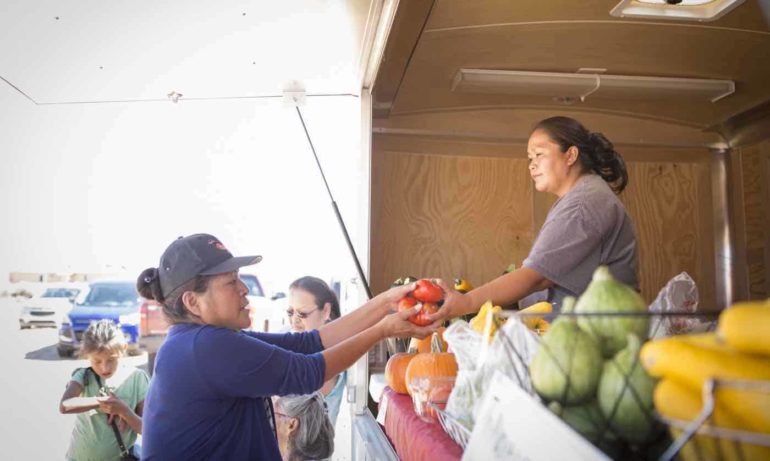Wholesome Wave and Navajo Nation are collaborating to increase healthy food access in Navajo Nation. Wholesome Wave is a nonprofit with the mission to inspire “under-served consumers to make healthier food choices by increasing affordable access to fresh, local and regional food.” One of Wholesome Wave’s programs is the Fruit and Vegetable Prescription Program (FVRx), in which healthcare providers prescribe fruits and vegetables to families in need. Navajo Nation, a Native American-governed territory that is comprised of portions of Utah, Arizona, and New Mexico, is one of the many communities nationwide implementing this FVRx program.
Food Tank had the opportunity to speak with four experts involved in the Wholesome Wave and Navajo Nation Partnership: Fiona McBride, Senior Associate of Communications and Public Outreach at Wholesome Wave; Amanda Morgan, Senior Program Manager of the FVRx Program at Wholesome Wave; Taylor Wilmot, Food Access Coordinator at the Community Outreach Patient Empowerment (COPE) Project in New Mexico; and Memarie Tsosie, Food Access Manager at Partners in Health, who works with with COPE and Navajo Nation.
Food Tank (FT): How was this partnership between Navajo Nation and Wholesome Wave created and what are its goals?
The Community Outreach Patient Empowerment (COPE) Project received a Racial and Ethnic Approaches to Community Health (REACH) grant from the Centers for Disease Control and Prevention to implement culturally appropriate programs within Navajo Nation to address health disparities. Navajo Nation teamed up with Wholesome Wave FVRx staff to implement the FVRx program model in Navajo Nation communities.
FT: Please explain how you are using Wholesome Wave’s Fruit and Vegetable Prescription Program as a model and how it will help improve food insecurity. Are there other models you are using?
The FVRx program is just one of the projects implemented within the REACH grant. Outreach Coordinators and Clinic Providers work together to recruit families who are at high risk for obesity and chronic disease. Doctors write out the voucher prescriptions that can be used to purchase produce, and families have to complete evidence-based nutrition education. The program has allowed for fruits and vegetables to be visible to the whole community.
FT: Please elaborate on how reinstating the tribal food system will help improve the health and economy of the Navajo community.
The Mobile Farmers Market, a project started with a few families recreating their farmer plot, has been very successful. Families see success in planting again and are incorporating new vegetables in their gardens. The group quickly expanded from five families last year to ten families this year, with more produce this year and the ability to accept vouchers at the mobile market. We expect it to grow, as more families are getting involved and asking to start their own gardens.
FT: What have been the greatest challenges so far? What challenges do you anticipate?
One of the greatest challenges has been getting the retailers to support the idea of the FVRx program. They asked, “How are the families going to prepare their food? Is it really going to work?” Also, getting larger stores on board is challenging; convenience stores typically make their money off of junk food. And, stores are having trouble finding wholesale distributors who sell at a low price.
Another challenge is that some food insecure families are excluded from the FVRx program because the clinic is only recruiting families with high rates of obesity and diabetes. These families need encouragement to go to the clinic; however, some families don’t want to be associated with a program that is related to obesity and disease.
FT: How is the Navajo community responding to this partnership and what noticeable improvements have you seen so far?
Communities have responded really well. The amount of produce purchased in stores has increased, and families are snacking on apples or avocados instead of candy. One family tells the story of their family member who was not eligible for surgery because she was so unhealthy. But with the FVRx program, she got healthier and was able to have surgery.
As more people learn about the FVRx program, there is growing interest in starting projects all over Navajo; other tribal groups are reaching out to participate too. Navajo Nation and Wholesome Wave hopes to work with these other communities and to start conversations about bringing the FVRx to other parts of the country.






